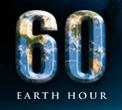
One's first impression of Earth Hour is that it is a noble but token gesture to try to get the community to jointly recognise the need for global sustainability. The actual impact of turning power off for one hour on a weekend will do squat to reduce the world's greenhouse gas emissions. The physical effect is akin to turning off one light globe while China and the US burn millions of tonnes of CO2 - not even a speck in the universe.
But when one reads about Earth Hour further and realises it is inspired by the World Wildlife Fund (WWF) to raise global awareness about the impact of green house emissions on the natural environment, one starts to appreciate the significance of Earth Hour. The benefit of Earth Hour is communicating awareness of the problem across ordinary citizens around the world, which is a logical and sensible first step in making change. It also helps raise awareness and respect for what WWF itself is trying to achieve.
The WWF is "one of the world's largest and most respected independent conservation organizations". Its mission is "to stop the degradation of the Earth's natural environment and build a future where people live in harmony with nature." Earth Hour "is a call to stand up, to take responsibility, to get involved and lead the way towards a sustainable future." SOURCE: EARTH HOUR
So what is the scale of the emissions problem that the WWF is trying to draw attention to?
"In per capita terms, emissions from the U.S. power sector are the second highest in the world. Americans’ electricity usage produces about 9.5 tons of CO2 per person per year, compared to 2.4 tons per person per year in China, 0.6 in India, and 0.1 in Brazil. Average per capita emissions from electricity and heat production in the EU is 3.3 tons per year. Only Australia, at greater than 10 tons per year, emits more power-related emissions per person than the U.S. In many developing countries, per capita power consumption is extremely low, and millions of people lack access to electricity at all." SOURCE: Centre for Global Development
"Earth Hour has almost 5 million supporters and a global network in over 100 countries, it’s one of the world's largest and most respected independent conservation organizations. WWF’s mission is to stop the degradation of the Earth's natural environment and build a future where people live in harmony with nature.
In March 2009, hundreds of millions of people took part in the third Earth Hour. Over 4000 cities in 88 countries officially switched off to pledge their support for the planet, making Earth Hour 2009 the world’s largest global climate change initiative."
So in anyone's terms, Earth Hour, is a success in repeatedly raising global awareness about the emissions problem. The next step is those same supporters influencing political decision makers to make the changes each year to reduce human greenhouse gas emissions.
New economic modelling indicates the world has just five years to initiate a low carbon industrial revolution before runaway climate change becomes almost inevitable.
And what is the WWF trying to achieve?
"WWF-Australia believes that in order to stay below a 2 degree Celsius temperature rise, the Australian Government must implement a national plan to reduce Australia's greenhouse gas emissions.
This plan must:
* Reduce carbon pollution by at least 25% by 2020 and 90% by 2050;
* Implement an emissions trading scheme operational by mid 2011 at the latest;
* Increase to 40% by 2030 the Renewable Energy Target (RET) and modify it or implement a feed-in-tariff to better support emerging technologies like geothermal, wave and solar thermal;
* Provide a fund to encourage landholders to preserve and grow trees to absorb carbon pollution and protect habitat;
* Implement world's best practice for energy efficiency and vehicle emission standards;
* Ensure two to three carbon capture and storage commercial projects are operational by 2015 and that no new coal-fired power stations are built unless they undertake carbon capture and storage; and
* Build on Copenhagen Accord to deliver a fair, ambitious and legally binding agreement in Mexico in 2010."SOURCE: WWF on Climate Change 
Meanwhile, on the Friday before Earth Hour I gaze out of the window from a 17th floor Sydney office building and see today another clear blue sky. But at the horizon blanketing Sydney’s suburbs rests a brown murky haze that is pollution from road transport and industry. It happens every day in every city around the globe. Like smoking over a lifetime, the combined effect of those thousands and thousands of repeated days of brown murky haze in every city are taking their toll on the health of the planet.

Comments
Vivienne (not verified)
Sat, 2010-03-27 09:48
Permalink
Government policies are contrary to the ideals of Earth Hour
quark
Sun, 2010-03-28 10:47
Permalink
Earth Hour
tim
Sun, 2010-03-28 12:55
Permalink
Earth Hour-- a noble, or a counter-productive cause?
Tigerquoll
Mon, 2010-03-29 10:11
Permalink
Earth Hour - next steps are not starting with government
Add comment